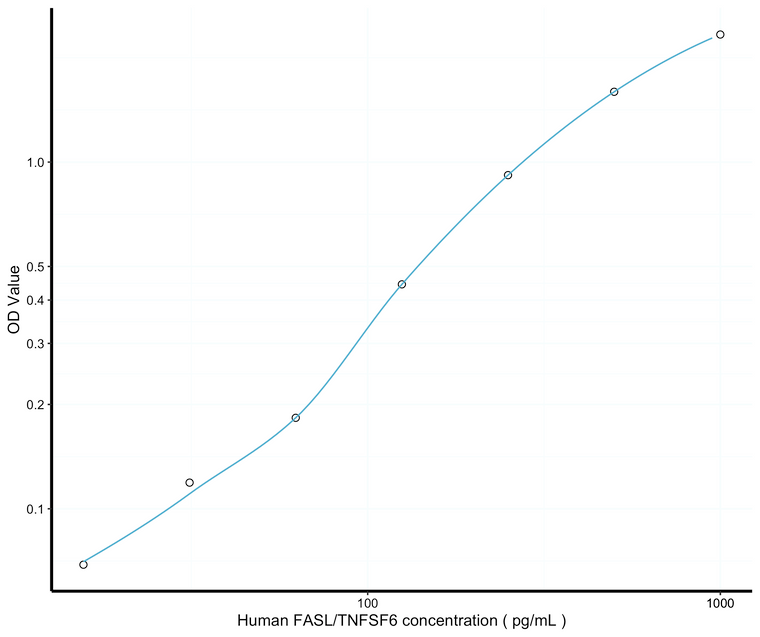| Applications: |
ELISA |
| Reactivity: |
Human |
| Note: |
FOR SCIENTIFIC EDUCATIONAL RESEARCH USE ONLY (RUO). MUST NOT BE USED IN DIAGNOSTIC OR OTHER MEDICAL APPLICATIONS. |
| Sensitivity: |
9.38pg/mL |
| Detection Limit: |
15.63~1000pg/mL |
| Short Description: |
This FASLG Sandwich ELISA is an in-vitro enzyme-linked immunosorbent assay for the measurement of samples in human cell culture supernatant, serum and plasma (EDTA, citrate, heparin). |
| Storage Instruction: |
If unopened the kit may be stored at 2-8°C for up to 1 month. If the kit will not be used within 1 month, store the components separately, according to the component table in the manual. |
| Assay Time: |
3.5h |
| Detection: |
Colormetric |
| Gene Symbol: |
FASLG |
| Gene ID: |
356 |
| Uniprot ID: |
TNFL6_HUMAN |
| Specificity: |
This kit recognizes Human FASL/TNFSF6 in samples. No significant cross-reactivity or interference between Human FASL/TNFSF6 and analogues was observed. |
| Sample Type: |
Serum, plasma and other biological fluids |
| Function | Cytokine that binds to TNFRSF6/FAS, a receptor that transduces the apoptotic signal into cells. Involved in cytotoxic T-cell-mediated apoptosis, natural killer cell-mediated apoptosis and in T-cell development. Initiates fratricidal/suicidal activation-induced cell death (AICD) in antigen-activated T-cells contributing to the termination of immune responses. TNFRSF6/FAS-mediated apoptosis has also a role in the induction of peripheral tolerance. Binds to TNFRSF6B/DcR3, a decoy receptor that blocks apoptosis. Tumor necrosis factor ligand superfamily member 6, soluble form: Induces FAS-mediated activation of NF-kappa-B, initiating non-apoptotic signaling pathways. Can induce apoptosis but does not appear to be essential for this process. FasL intracellular domain: Cytoplasmic form induces gene transcription inhibition. |
| Protein Name | Tumor Necrosis Factor Ligand Superfamily Member 6Apoptosis Antigen LigandAptlCd95 LigandCd95-LFas Antigen LigandFas LigandFaslCd Antigen Cd178 Cleaved Into - Tumor Necrosis Factor Ligand Superfamily Member 6 - Membrane Form - Tumor Necrosis Factor Ligand Superfamily Member 6 - Soluble FormReceptor-Binding Fasl EctodomainSoluble Fas LigandSfasl - Adam10-Processed Fasl FormApl - Fasl Intracellular DomainFasl IcdSppl2a-Processed Fasl FormSpa |
| Database Links | Reactome: R-HSA-140534Reactome: R-HSA-3371378Reactome: R-HSA-5213460Reactome: R-HSA-5218900Reactome: R-HSA-6785807Reactome: R-HSA-69416Reactome: R-HSA-75157Reactome: R-HSA-8862803Reactome: R-HSA-9614657 |
| Cellular Localisation | Cell MembraneSingle-Pass Type Ii Membrane ProteinCytoplasmic Vesicle LumenLysosome LumenIs Internalized Into Multivesicular Bodies Of Secretory Lysosomes After Phosphorylation By Fgr And MonoubiquitinationColocalizes With The Sppl2a Protease At The Cell MembraneTumor Necrosis Factor Ligand Superfamily Member 6Soluble Form: SecretedMay Be Released Into The Extracellular Fluid By Cleavage From The Cell SurfaceFasl Intracellular Domain: NucleusThe Fasl Icd Cytoplasmic Form Is Translocated Into The Nucleus |
| Alternative ELISA Names | Tumor Necrosis Factor Ligand Superfamily Member 6 ELISA kitApoptosis Antigen Ligand ELISA kitAptl ELISA kitCd95 Ligand ELISA kitCd95-L ELISA kitFas Antigen Ligand ELISA kitFas Ligand ELISA kitFasl ELISA kitCd Antigen Cd178 Cleaved Into - Tumor Necrosis Factor Ligand Superfamily Member 6 - Membrane Form - Tumor Necrosis Factor Ligand Superfamily Member 6 - Soluble Form ELISA kitReceptor-Binding Fasl Ectodomain ELISA kitSoluble Fas Ligand ELISA kitSfasl - Adam10-Processed Fasl Form ELISA kitApl - Fasl Intracellular Domain ELISA kitFasl Icd ELISA kitSppl2a-Processed Fasl Form ELISA kitSpa ELISA kitFASLG ELISA kitAPT1LG1 ELISA kitCD95L ELISA kitFASL ELISA kitTNFSF6 ELISA kit |
| Specificity | This kit recognizes Human FASL/TNFSF6 in samples. No significant cross-reactivity or interference between Human FASL/TNFSF6 and analogues was observed. |
| Reproducibility | Both intra-CV and inter-CV are |
Information sourced from Uniprot.org
| Item | Specifications | Storage |
| Micro ELISA Plate (Dismountable) | 96T: 8 wells ×12 strips strips | -20℃, 6 months |
| Reference Standard | 96T: 2 vials 48T: 1 vial | -20℃, 6 months |
| Concentrated Biotinylated Detection Ab (100×) | 96T: 1 vial, 120 μL 60 μL | -20℃, 6 months |
| Concentrated HRP Conjugate (100×) | 96T: 1 vial, 120 μL 60 μL | -20℃ (Protect from light), 6 months |
| Reference Standard & Sample Diluent | 1 vial, 20 mL | 2-8°C, 6 months |
| Biotinylated Detection Ab Diluent | 1 vial, 14 mL | 2-8°C, 6 months |
| HRP Conjugate Diluent | 1 vial, 14 mL | 2-8°C, 6 months |
| Concentrated Wash Buffer (25×) | 1 vial, 30 mL | 2-8°C, 6 months |
| Substrate Reagent | 1 vial, 10 mL | 2-8℃ (Protect from light) |
| Stop Solution | 1 vial, 10 mL | 2-8°C |
| Plate Sealer | 5 pieces | |
| Manual | 1 copy | |
| Certificate of Analysis | 1 copy | |
| Sample Type | Range (%) | Average Recovery (%) |
| Serum(n=8) | 95-108 | 102 |
| EDTA plasma (n=8) | 93-109 | 100 |
| Cell culture media (n=8) | 87-99 | 94 |
| | Intra-assay Precision | Intra-assay Precision | Intra-assay Precision | Inter-assay Precision | Inter-assay Precision | Inter-assay Precision |
| Sample | 1.00 | 2.00 | 3.00 | 1.00 | 2.00 | 3.00 |
| n | 20.00 | 20.00 | 20.00 | 20.00 | 20.00 | 20.00 |
| Mean (pg/mL) | 50.15 | 142.30 | 454.75 | 50.49 | 135.64 | 412.66 |
| Standard deviation | 2.94 | 8.24 | 14.92 | 2.90 | 6.47 | 15.76 |
| CV (%) | 5.86 | 5.79 | 3.28 | 5.74 | 4.77 | 3.82 |
12 months for antibodies. 6 months for ELISA Kits. Please see website T&Cs for further guidance








